The Fermi All-Sky Cake
- By Maggie Masetti
- February 6, 2014
- Comments Off on The Fermi All-Sky Cake
If the idea of a Fermi cake sounds familiar, it’s because we featured the cake replica of the Fermi satellite for its 5th birthday.
Our science bakers were at it again for a Science as Food competition that was part of a recent science poster event. Judy Racusin along with grad students Sylvia Zhu and David Green created this masterpiece which features the gamma-ray sky, as seen by Fermi, in scientifically accurate cake-format.
Sylvia and David answered some questions for us about how they made the cake and the science that went into it.

Credit: Judy Racusin
NASA Blueshift: What is your job on the Fermi project?
David: I am a graduate student over at the University of Maryland (UMD). I use the LAT (Large Area Telescope) on Fermi to study cosmic rays and help maintain the calibrations of the ACD (anti-coincidence detector) which is a subsystem on the LAT that detects and filters out cosmic rays from the gamma-ray data.
Sylvia: I’m a UMD physics grad student. I work with Fermi-LAT data to study the high-energy emission from gamma-ray bursts.
NASA Blueshift: What gave you all the idea to do a Fermi cake? What is the significance of the Fermi sky map?
Sylvia: For last year’s Science as Food competition, we made a model of a pulsar that showed where both the radio emission (the more traditional lighthouse model) and the gamma-ray emission come from. Our cake ended up being a little … cartoonish. This year, we decided to create something different, something more subdued and less literal (i.e., not just another model of an astronomical object). And then we forgot about it for a while, and time was running out, and then we realized that the Fermi bubbles would be the perfect subject of our entry: Judy and I had experience making the LAT skymap before, and we had all had experience (with varying amounts of success) creating sugar sculptures, so we wouldn’t need to spend a lot of experimenting and learning new techniques this time. The bubbles were discovered with the launch of Fermi (although there were hints of it in the WMAP data), and are a great example of how there is still so much to discover even in our own galaxy. [Ed. note: Those are the large pink 3D structures you see at the center of the cake. Read more in a past Blueshift blog about Fermi bubbles.]
David: It took a little while to figure out we wanted to focus on the Fermi bubbles. It was a combination of ‘how will this look’ vs ‘can we pull this off?’. We kicked around some other ideas of an accretion disk on to a compact object or a nova of some sort but those proved to be a bit too complicated.
We then kind of all agreed we should do something with the Fermi bubbles because we all just came back AAS and Douglas Finkbeiner, Tracy Slatyer, and Meng Su just won the Rossi Prize for their work on the Fermi bubbles. It was relevant, showed off one of the big discoveries of Fermi, and something that could pull off with a few days work.
We then had to settle on what to do with the Fermi bubbles. Sylvia and Judy had already done a Fermi sky map for the four year anniversary of Fermi back in 2012. Since we familiar with the sky map from before we decided to just do a bigger version, add in the bubbles, and LEDs for bright sources. We also really liked the sky map because it shows off a lot of science in one image. You have both galactic and extra galactic sources, stable and transient sources, diffuse gamma ray emission, and the fact that Fermi is an all sky telescope, we see the entire sky every three hours.
NASA Blueshift: How did you paint the sky? How were the bubbles made and what do they represent astronomically?
David: Sylvia painted the sky so hopefully she can answer that question. As Judy said I made the bubbles. For those I started off with a large foam block a cut and sanded it down to the size and shape we wanted. We decided to go with a slight exaggeration of the bubbles, about 50% larger than how they actually appear on the sky, more for aesthetics.
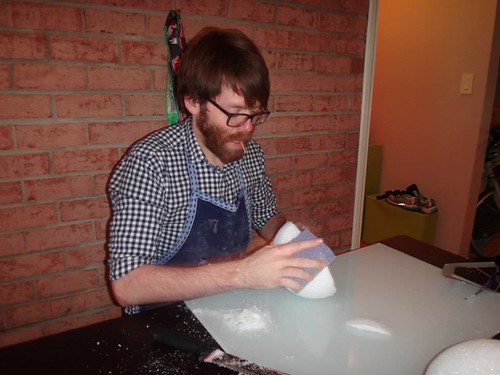
David cut the bubbles out of foam and then sands down the foam into the right shape. Credit: Sylvia Zhu/David Green
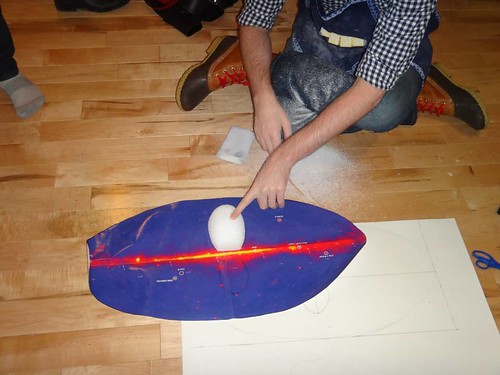
They look to see how big the Fermi bubbles will be on the rest of the sky map. Credit: Sylvia Zhu/David Green
We then wrapped the foam in clay that hardens when you bake it in the oven. Took out the foam, baked the clay and we had our bubble mold. We wrapped the mold in tin foil to make sure it was food safe and put it in the freezer. We then made hard candy both colored and flavored and poured the molten candy into the mold. Since the mold was very cold the candy hardened pretty quickly and all we had to do was constantly coat the sides of the mold to make the bubbles. We then just removed the bubbles from the mold and took off the tin foil. We actually made about five bubbles just in case one would break.
The bubbles represent a large and rather unexpected structure of the galaxy only seen in diffuse gamma ray emission. The bubbles extend 25,000 light years both above and below the galactic plane and could be the remnants of an ancient jet from the Galactic center, like what see in other distant AGNs (active galactic nuclei). There is still a lot unknown about the bubbles but continued observations by Fermi are sure to shed more light on their nature and origin.
Sylvia: I painted the cake by hand using a poster of the Fermi skymap as a reference. I started with the yellows, then the reds, and finally the blues and dark blues, building the skymap outward from the sources rather than layering the brighter colors on top of the darker ones (as I wasn’t confident that the colors would layer well). I used a water-based food coloring, and thinned the colors with a bit of vodka that quickly evaporated. The food dyes weren’t pure colors — the blue was a bit green, the black was more of a very dark green — which made mixing them difficult, so in the end I kept the color mixing to a minimum. The surface of the cake was marshmallow fondant.

Sylvia cuts the cake into the proper Aitoff Projection. Credit: Sylvia Zhu/David Green
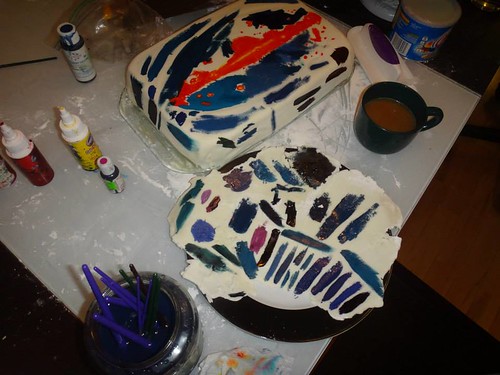
Here they tested the colors for the sky map. Getting a good blue proved harder than they thought. Credit: Sylvia Zhu/David Green
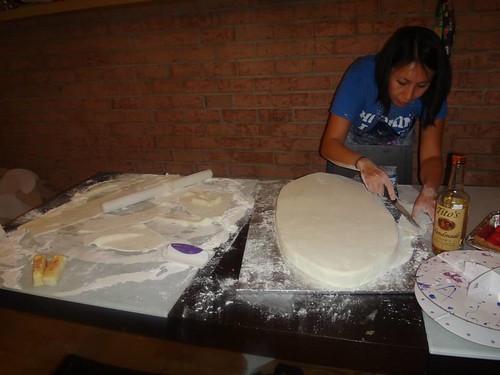
Sylvia smooths out the fondant where she will soon paint the sky map. Credit: Sylvia Zhu/David Green

Sylvia makes the title “Fermi Gamma-Ray Sky” in chocolate. Credit: Sylvia Zhu/David Green
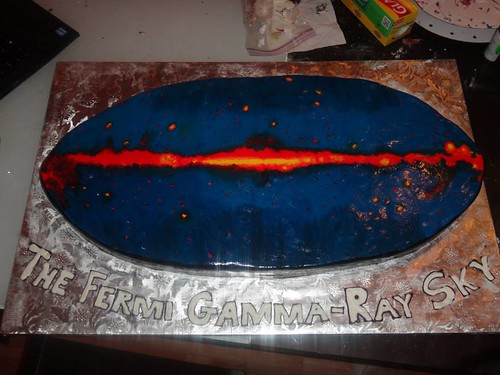
The painted cake minus bubbles. Credit: Sylvia Zhu/David Green
The bubbles were made out of poured sugar, which is sugar that is melted and heated to a “hard crack” temperature so that it stays solid and translucent when cooled. David created the mold for the bubbles by sanding down styrofoam to the right shape, then covering the styrofoam in a layer of polymer clay. He cured the polymer clay in the oven; when cured, polymer clay can withstand temperatures of about 380 deg F before smoking, and poured sugar gets to a max temperature of around 300 deg F. We chose polymer clay for its ease of use (as we don’t have access to an actual kiln). The sugar was tinted red / purple and flavored with a bit of pomegranate flavoring.
NASA Blueshift: How did you make the gamma ray sources in the sky blink and are they astronomically/scientifically accurate?
Sylvia: We used purple LEDs to emphasize the brightest Fermi sources: Vela, Geminga, the Crab nebula, the blazar 3C 454.3, the Cygnus region, and a few other sources. These were LEDs with self-contained batteries, as we didn’t want to fiddle with extra wires in the cake. Half of them blinked and half were steady; we used the blinking ones for the pulsars, and the steady ones for the active galactic nuclei.
David: We put the blinking LEDs at famous gamma-ray pulsar locations through out the galaxy. Specifically, Vela, Geminga, the Crab Pulsar, CTA 1, and the Cygnus region. All the LEDs blinked at the same rate, we would have liked for the LEDs to blink at the same rate of the pulsars but we didn’t have enough time do that.
We then put the stable LEDs at AGN locations which typically don’t pulse (but do flare on a irregular basis). We put then namely at 3C454.3 and some random other AGNs (none of us study AGNs actually… ).
Basically their locations are accurate but the period of pulsation is not.
NASA Blueshift: This cake is definitely not a lie! [Yes, yes, we’ve totally overused the Portal joke! WE DO WHAT WE WANT!]
The finished cake:
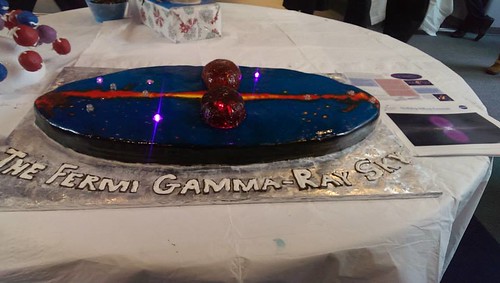
Credit: Sylvia Zhu/David Green
Proof the Universe is edible?
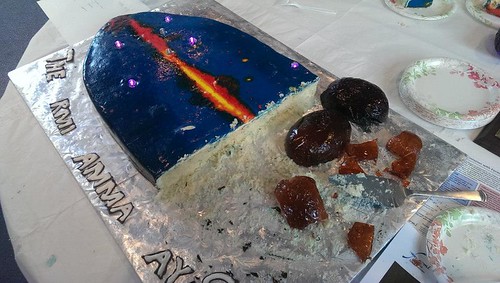
Credit: Sylvia Zhu/David Green


